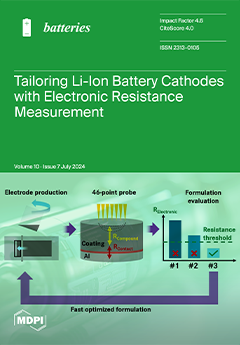This study focuses on the growth of Cu
2O/CuO nanowires by one-step thermal oxidation using a flexible copper mesh at oxidation temperatures in the range of 300 to 600 °C in a controlled atmosphere of mixed-flow Ar and O
2 gases. Thermal oxidation is one of the simplest used methods to obtain nanowires on a metal surface, offering advantages such as low production costs and the ability to produce metal oxides on a large scale without the use of hazardous chemical compounds. The growth of metal oxides on a conductive substrate, forming metal/oxide structures, has proven to be an effective method for enhancing charge-transfer efficiency. The as-synthesized Cu/Cu
2O/CuO (Nw) electrodes were structurally and morphologically characterized using techniques such as XRD and SEM/EDX analysis to investigate the structure modification and morphologies of the materials. The supercapacitor properties of the as-developed Cu/Cu
2O/CuO (Nw) electrodes were then examined using cyclic voltammetry (CV), galvanostatic charge–discharge (GCD) measurements, and electrochemical impedance spectroscopy (EIS). The CV curves show that the Cu/Cu
2O/CuO (Nw) structure acts as a positive electrode, and, at a scan rate of 5 mV s
−1, the highest capacitance values reached 26.158 mF cm
−2 for the electrode oxidized at a temperature of 300 °C. The assessment of the flexibility of the electrodes was performed at various bending angles, including 0°, 45°, 90°, 135°, and 180°. The GCD analysis revealed a maximum specific capacitance of 21.198 mF cm
−2 at a low power density of 0.5 mA cm
−2 for the oxidation temperature of 300 °C. The cycle life assessment of the all of the as-obtained Cu/Cu
2O/CuO (Nw) electrodes over 500 cycles was performed by GCD analysis, which confirmed their electrochemical stability.
Full article





